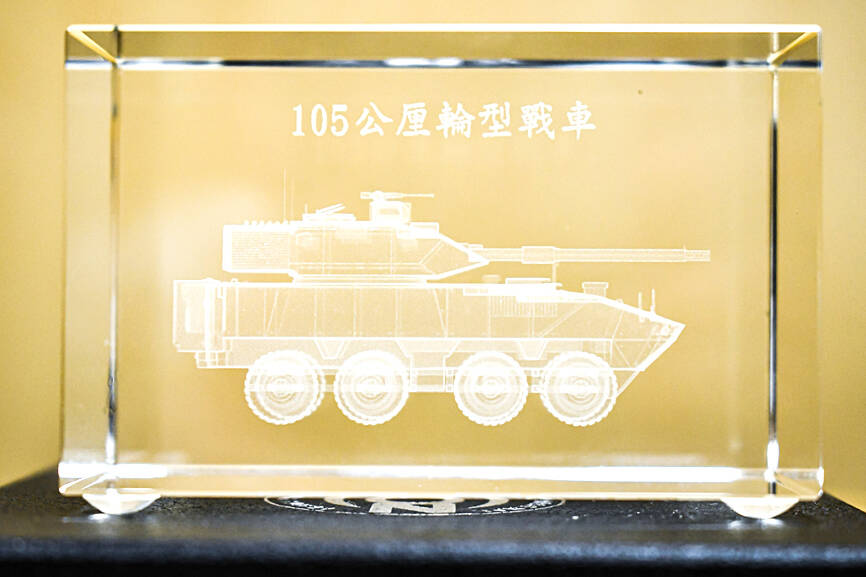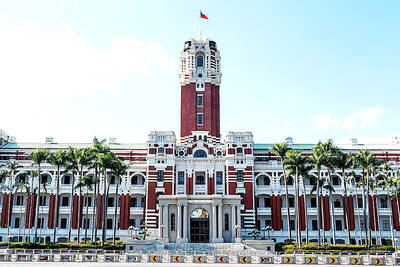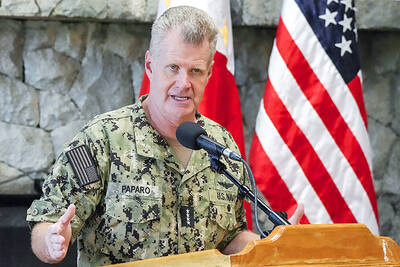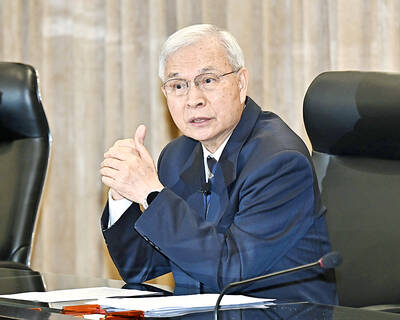Taiwan’s experimental eight-wheeled armored combat vehicle equipped with an 105mm gun passed an initial operational capability assessment in October last year, clearing the path for mass production this year, the Ministry of National Defense said.
The ministry made the announcement in a written report to the Legislative Yuan ahead of tomorrow’s legislative hearing on the progress of indigenous weapons development programs.
The prototype, the designation of which has not yet been revealed, was derived from the CM-33 Clouded Leopard armored vehicles, but has significantly heavier firepower and an improved chassis.

Photo: Taipei Times
The army’s combined arms brigades on Taiwan proper would be the first to receive the new armored combat vehicles, a defense official with knowledge of the matter said, speaking on condition of anonymity.
After that, the army plans to use the chassis designed for the new vehicles to upgrade all Clouded Leopard models, improving their maneuverability and survivability, and ensuring part standardization across the fleet, the official said.
Units on the nation’s outlying islands would then receive Clouded Leopard vehicles to replace their M41D Walker Bulldogs and CM21 armored personnel carriers, which until now were the only vehicles compact enough to operate there, given the infrastructure on the islands, they said.
The new chassis has a lower clearance, which reduces the vehicle’s overall height, making it harder to detect or hit, the official said.
It also features a shorter turning radius and is narrower, boosting the vehicle’s maneuverability, which is key for urban warfare, they said.
The Marine Corps has also expressed interest in the new armored combat vehicle as a replacement for its M60A3 Patton tanks, which are almost too large for Taiwan’s landing ships, the official said.
The marines are prioritizing the acquisition of an 81mm mortar carrier based on the Humvee that was developed by the Armaments Bureau, instead of a 120mm mortar carrier based on the CM-33 Clouded Leopard model, the official said.
The Marine Corps believes the lighter and more mobile 81mm mortar carrier is a better fit for its “fast-in, fast-out” doctrine, despite having less firepower and protection, the official said.
In its report, the defense ministry detailed progress made by the nation’s indigenous arms development programs.
Under the Advanced Trainer Jet program, Taiwan has ordered 66 AIDC T-5 Brave Eagle jets, of which 27 have been delivered since 2020, the report said, adding that the remainder are expected be delivered over the next two years.
The navy’s indigenous ship-building programs for landing platform docks, search-and-rescue vessels, next-generation corvettes and cutters, fast minelayers and submarines are all proceeding according to schedule, with several vessels having been delivered, the ministry said.
Since the Clouded Leopard vehicle program was launched in 2011, the Armaments Bureau has produced 378 CM-32 and CM-33 vehicles armed with automatic grenade launchers, and 305 CM-34 vehicles armed with 30mm cannons, delivering all that were ordered, it said.
A wheeled tactical reconnaissance vehicle designed for speed and agility is being developed, and the initial operational capability assessment has been tentatively scheduled for October, it said.
The ministry said it has completed delivery of new light sniper rifles, while a new heavy sniper rifle has passed an initial assessment and deliveries are expected to begin late this year.
The T112 assault rifle, a gun featuring red dot optics, infrared illuminators and other modern ergonomic features, passed an initial assessment in November last year and is on its way to becoming the army’s next standard-issue weapon, it said.
A new type of ballistic plate for infantry body armor capable of resisting the Chinese People’s Liberation Army’s steel-core, armor-piercing 5.8×42mm ammunition was developed late last year, the ministry said, adding that they are expected to enter mass production.

The CIA has a message for Chinese government officials worried about their place in Chinese President Xi Jinping’s (習近平) government: Come work with us. The agency released two Mandarin-language videos on social media on Thursday inviting disgruntled officials to contact the CIA. The recruitment videos posted on YouTube and X racked up more than 5 million views combined in their first day. The outreach comes as CIA Director John Ratcliffe has vowed to boost the agency’s use of intelligence from human sources and its focus on China, which has recently targeted US officials with its own espionage operations. The videos are “aimed at

STEADFAST FRIEND: The bills encourage increased Taiwan-US engagement and address China’s distortion of UN Resolution 2758 to isolate Taiwan internationally The Presidential Office yesterday thanked the US House of Representatives for unanimously passing two Taiwan-related bills highlighting its solid support for Taiwan’s democracy and global participation, and for deepening bilateral relations. One of the bills, the Taiwan Assurance Implementation Act, requires the US Department of State to periodically review its guidelines for engagement with Taiwan, and report to the US Congress on the guidelines and plans to lift self-imposed limitations on US-Taiwan engagement. The other bill is the Taiwan International Solidarity Act, which clarifies that UN Resolution 2758 does not address the issue of the representation of Taiwan or its people in

US Indo-Pacific Commander Admiral Samuel Paparo on Friday expressed concern over the rate at which China is diversifying its military exercises, the Financial Times (FT) reported on Saturday. “The rates of change on the depth and breadth of their exercises is the one non-linear effect that I’ve seen in the last year that wakes me up at night or keeps me up at night,” Paparo was quoted by FT as saying while attending the annual Sedona Forum at the McCain Institute in Arizona. Paparo also expressed concern over the speed with which China was expanding its military. While the US

SHIFT: Taiwan’s better-than-expected first-quarter GDP and signs of weakness in the US have driven global capital back to emerging markets, the central bank head said The central bank yesterday blamed market speculation for the steep rise in the local currency, and urged exporters and financial institutions to stay calm and stop panic sell-offs to avoid hurting their own profitability. The nation’s top monetary policymaker said that it would step in, if necessary, to maintain order and stability in the foreign exchange market. The remarks came as the NT dollar yesterday closed up NT$0.919 to NT$30.145 against the US dollar in Taipei trading, after rising as high as NT$29.59 in intraday trading. The local currency has surged 5.85 percent against the greenback over the past two sessions, central